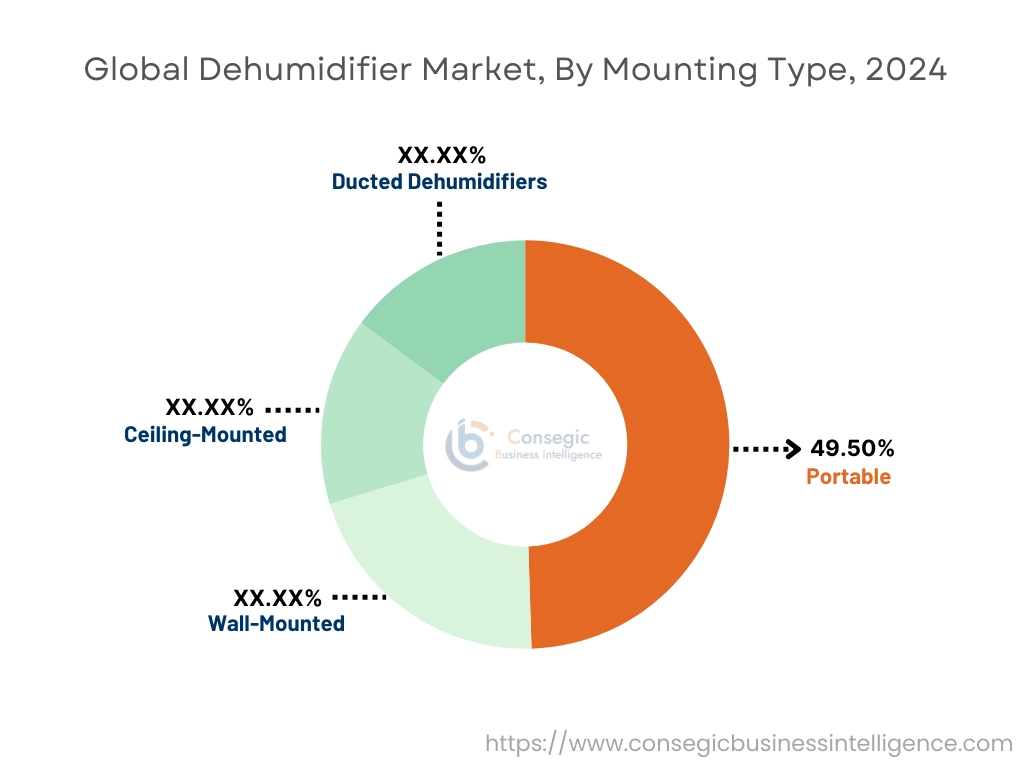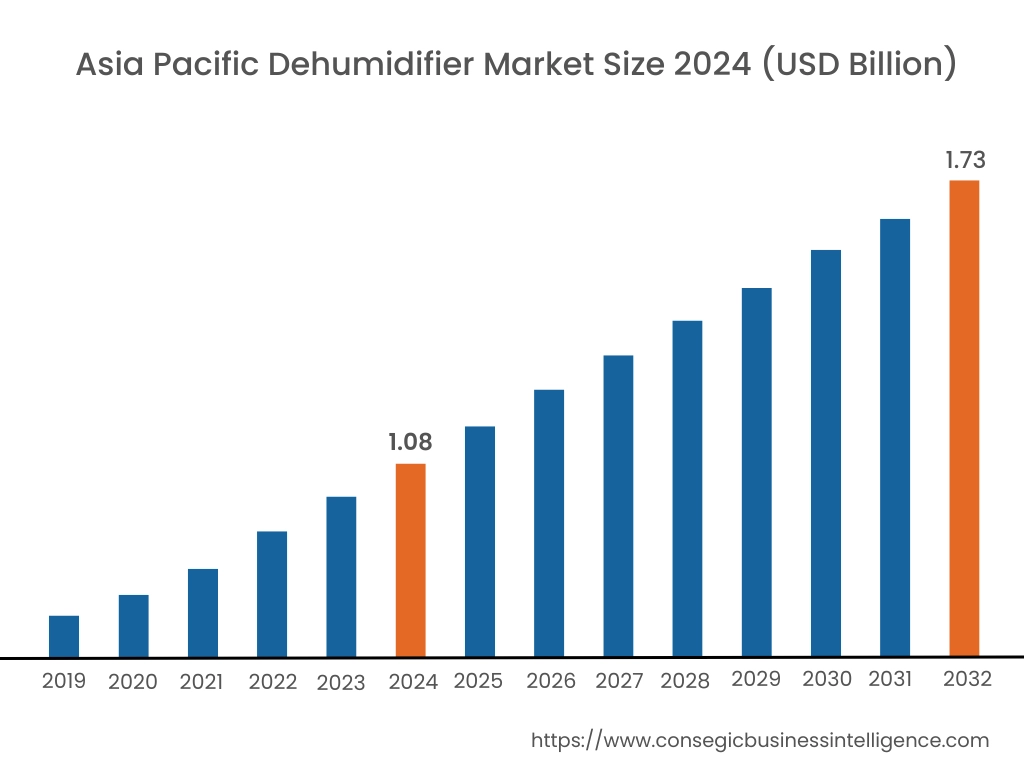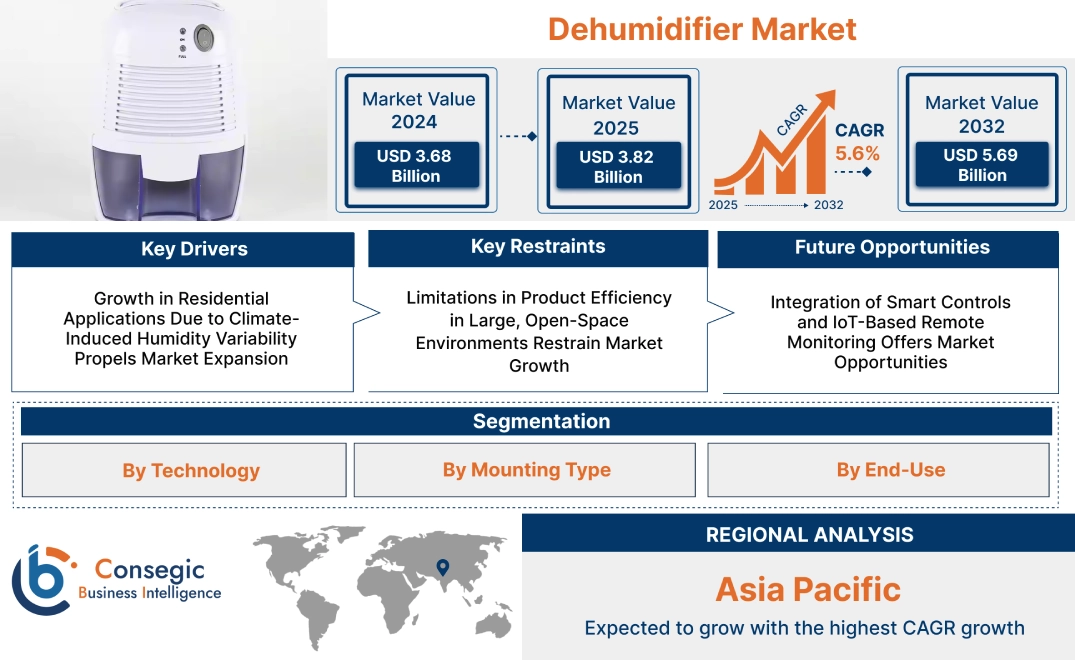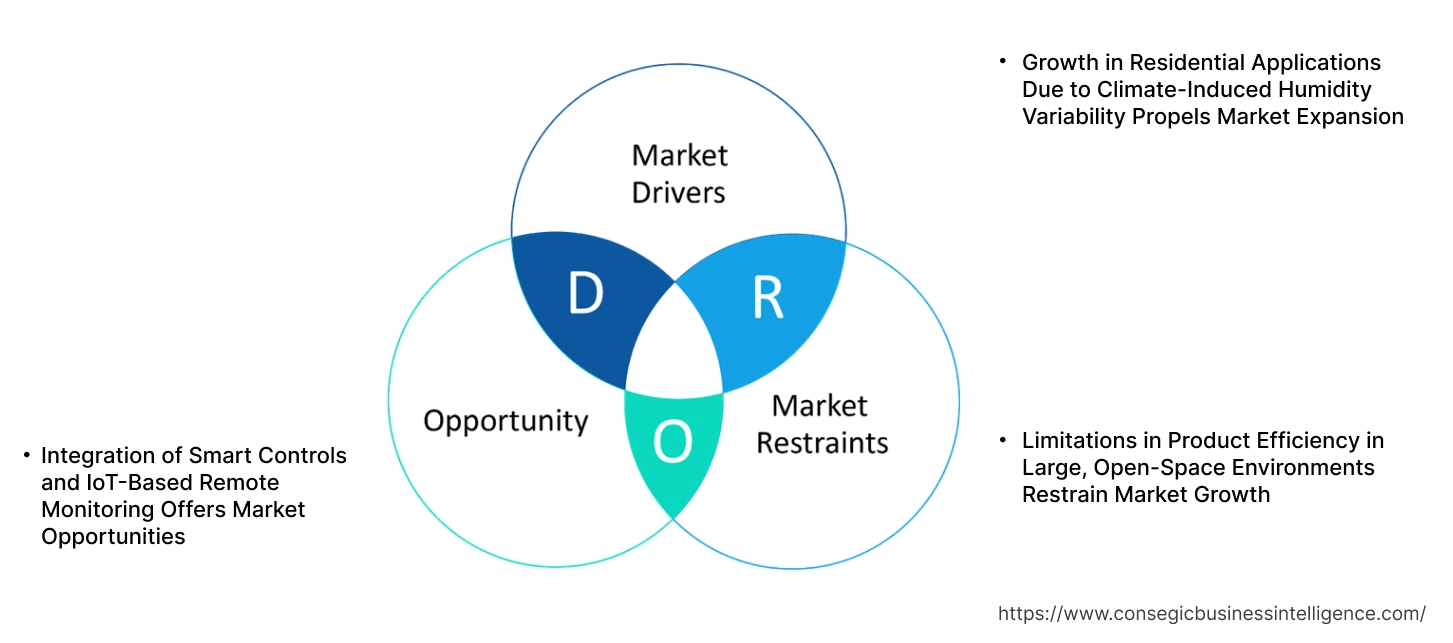- Summary
- Table Of Content
- Methodology
Dehumidifier Market Size:
Dehumidifier Market size is estimated to reach over USD 5.69 Billion by 2032 from a value of USD 3.68 Billion in 2024 and is projected to grow by USD 3.82 Billion in 2025, growing at a CAGR of 5.6% from 2025 to 2032.
Dehumidifier Market Scope & Overview:
A dehumidifier is a climate control appliance designed to extract excess moisture from the air, improving indoor air quality and preventing condensation-related issues. It is commonly used in residential, commercial, and industrial environments to maintain optimal humidity levels and protect infrastructure, electronics, and stored goods from mold, corrosion, and dampness.
Key features include adjustable humidity settings, energy-efficient operation, automatic shut-off, and integrated air filters. These systems offer quiet performance, digital controls, and portability, allowing flexible placement and user convenience. Advanced models include continuous drainage options and built-in hygrometers for precise monitoring.
Warehouses, basements, healthcare facilities, and data centers utilize them to ensure environmental stability and promote health and material longevity. Their ability to operate in varied climatic conditions and adapt to space-specific requirements enhances reliability across sectors. Ongoing design improvements continue to enhance operational efficiency, extending usability in both temporary and long-term humidity management applications.
Key Drivers:
Growth in Residential Applications Due to Climate-Induced Humidity Variability Propels Market Expansion
Rising humidity levels linked to altered climate patterns have led to increased moisture buildup in residential buildings, particularly in tropical and coastal regions. Homeowners are experiencing higher rates of mold growth, wall seepage, and indoor discomfort. In response, portable and whole-home humidity control systems are being increasingly adopted to maintain indoor air quality and protect structural integrity. Residential dehumidifiers with digital humidistats, low-noise operation, and energy-efficient compressors are becoming more appealing to consumers seeking long-term comfort. Demand for solutions that prevent microbial growth, enhance HVAC efficiency, and protect furnishings is also growing in basement and attic installations. Real estate developers and HVAC contractors are beginning to integrate these systems into new constructions, especially in humidity-prone markets. This widespread adoption, driven by climate-related indoor air quality concerns, is a major contributor to dehumidifier market expansion.
Key Restraints:
Limitations in Product Efficiency in Large, Open-Space Environments Restrain Market Growth
Humidity regulation across expansive, open-plan spaces like factories, airport terminals, and auditoriums presents operational challenges. Standard dehumidification units often struggle to maintain uniform relative humidity due to thermal layering, inconsistent airflow distribution, and external air exchange. Achieving consistent performance in such environments requires either extensive zonal segmentation or the deployment of multiple high-capacity units, increasing equipment and operational complexity. Additionally, structural features like high ceilings and inadequate insulation reduce its efficiency and increase overall energy consumption. These inefficiencies limit the practicality of large-scale deployment in specific commercial and industrial settings, particularly where centralized climate control is already in place. The technical and cost-related constraints associated with achieving uniform humidity levels in open architectures present a notable limitation to broader application. As a result, this performance gap continues to act as a barrier to dehumidifier market growth.
Future Opportunities:
Integration of Smart Controls and IoT-Based Remote Monitoring Offers Market Opportunities
The integration of smart technologies into residential and commercial dehumidification systems is reshaping market expectations. IoT-enabled dehumidifiers offer real-time remote monitoring, automated humidity control, and cloud-based data analytics, allowing users to track indoor conditions and optimize performance. These capabilities are in high demand among tech-savvy consumers and facility managers seeking greater control, energy savings, and predictive maintenance alerts. Through app-based interfaces and smart home ecosystems, users are able to set humidity schedules, monitor filter life, and receive system alerts, improving convenience and reliability. Commercial buildings benefit from centralized humidity management through building automation systems (BAS), especially in healthcare, pharma, and precision manufacturing. This convergence of climate control and digital automation is driving innovation and differentiation among market players.
- For instance, in November 2024, Xiaomi launched the Mijia Smart Inverter Dehumidifier 30L in China, with dual-rotor technology, HyperOS and a built-in plasma generator. The large LCD screen displays temperature and humidity levels and the product can be controlled through XiaoAi.
The growing preference for connected devices and smart infrastructure is expected to unlock significant dehumidifier market opportunities driven by both requirement and technology-led growth.
Dehumidifier Market Segmental Analysis :
By Technology:
Based on technology, the market is segmented into thermal condensation (electric refrigeration dehumidifiers, spray dehumidifiers, and thermoelectric dehumidifiers), absorption/desiccant, and membrane dehumidification (selective membrane dehumidification and ionic membrane dehumidification).
The thermal condensation segment held the largest dehumidifier market share in 2024.
- Electric refrigeration dehumidifiers are widely used in residential and commercial buildings due to their cost-effectiveness and efficient moisture removal performance.
- These units utilize condenser coils to collect humidity from air, making them effective in environments with moderate to high ambient temperatures.
- Segmental analysis highlights the continuous adoption of thermal condensation systems in HVAC-integrated applications.
- Thus, the increasing requirement for smart and energy-efficient appliances has strengthened this segment’s role in dehumidifier market growth.
The membrane dehumidification segment is expected to exhibit the fastest CAGR during the forecast period.
- This segment includes selective and ionic membrane technologies, offering low-energy and maintenance-free operation.
- Its growing adoption in niche sectors such as defense, medical labs, and precision manufacturing boosts the segment.
- Dehumidifier market trends show a shift toward non-mechanical, silent dehumidification methods in sensitive environments.
- As industries seek cleanroom-compliant humidity control, membrane-based systems support market expansion.
By Mounting Type:
Based on mounting type, the market is segmented into portable, wall-mounted, ceiling-mounted and ducted dehumidifiers.
The portable segment dominated the market at 49.50% in 2024.
- These units offer flexibility and ease of installation, making them ideal for residential and small office use.
- Consumer need is rising for portable models integrated with digital humidity sensors and smart controls.
- Dehumidifier market analysis identifies strong sales through both online and offline retail channels.
- For instance, in January 2025, Aldi launched the Ambaino midi dehumidifier, a portable and reasonably priced model targeted for the winter season.
- Thus, energy efficiency certifications and low-noise operations are key drivers of continued demand in this category.
The ducted segment is expected to grow at the fastest CAGR during the forecast period.
- These systems are integrated with HVAC infrastructure and are ideal for commercial and industrial settings.
- Ducted models enable centralized control and uniform moisture removal across large areas.
- Market trends indicate that building automation and energy performance mandates support wider adoption.
- As commercial construction increases globally, this segment underpins long-term dehumidifier market expansion.

By End-Use:
Based on end-use, the dehumidifier market is segmented into residential, commercial, industrial, healthcare, pharmaceuticals, food & beverage, construction, and others.
The residential use segment accounted for the largest dehumidifier market share in 2024.
- Increasing awareness of indoor air quality and moisture-related health risks has boosted adoption in homes.
- The rising incidence of mold-related allergies and respiratory issues contributes to the market growth.
- Dehumidifier market trends show strong uptake in smart home ecosystems, with models linked to IoT-based climate management platforms.
- Additionally, government initiatives promoting energy-efficient appliances further drive household segment revenues.
The pharmaceuticals segment is anticipated to grow at the fastest CAGR during the forecast period.
- Stringent humidity control is essential for pharmaceutical production, packaging, and storage facilities.
- Adoption of specialized dehumidification systems ensures compliance with GMP and regulatory standards.
- Dehumidifier market analysis highlights increased investments in pharma infrastructure across Asia-Pacific and North America.
- Therefore, growth in the biotech sector, driven by vaccine and biologics manufacturing, reinforces this segment’s contribution to market expansion.
Regional Analysis:
The regions covered are North America, Europe, Asia Pacific, the Middle East and Africa, and Latin America.

Asia Pacific region was valued at USD 1.08 Billion in 2024. Moreover, it is projected to grow by USD 1.13 Billion in 2025 and reach over USD 1.73 Billion by 2032. Out of this, China accounted for the maximum revenue share of 38.4%. Asia-Pacific is the fastest-growing region in the global dehumidifier industry, driven by a combination of humid climate zones, rapid urbanization, and expanding middle-class consumer bases. China, India, Japan, and South Korea are indicating strong potential for residential and commercial adoption, particularly in coastal and monsoon-prone areas. Industrial sectors—including electronics manufacturing, pharmaceuticals, and warehousing—are also investing heavily in humidity control to safeguard sensitive products and machinery. Regional analysis highlights a rising trend toward locally manufactured units and customized solutions for small living spaces and high-rise apartments. As awareness of health impacts linked to damp environments increases, demand is expected to accelerate further.
- For instance, in January 2025, Sterra launched two new dehumidifier models, Sterra Ray and Sterra Titan, to combat Singapore's high humidity. Sterra Ray is suitable for small spaces like studio apartments and single rooms, while Sterra Titan is designed for industrial purposes.

North America is estimated to reach over USD 1.84 Billion by 2032 from a value of USD 1.22 Billion in 2024 and is projected to grow by USD 1.26 Billion in 2025. North America stands as a mature and highly active region in the dehumidifier market, supported by consistent demand across residential, commercial, and industrial environments. The United States and Canada exhibit widespread usage due to the need for indoor humidity control, particularly in basements, HVAC systems, and archival storage facilities. Analysis shows that rising concerns about mold prevention and indoor air quality are pushing requirement from both homeowners and property managers. Furthermore, the growing popularity of energy-efficient and smart dehumidification systems enhances replacement cycles and drives product innovation. There is also a noticeable push toward integrating dehumidification with centralized ventilation solutions, which continues to shape regional market behavior.
Europe represents a steadily expanding market, where demand is influenced by a combination of seasonal humidity and a growing emphasis on energy-efficient housing. Countries like the UK, Germany, France, and the Netherlands show rising usage in passive house construction, green building retrofits, and museums or cultural heritage conservation. The dehumidifier market demand in Europe is substantially influenced by government regulations around building health and moisture control. According to market analysis, this region offers a favorable environment for manufacturers offering compact, quiet, and smart-enabled units tailored for multi-family housing and mixed-use buildings. The provision of the dual goals of comfort and sustainability through adaptive humidity control systems is a potential market opportunity.
In Latin America, dehumidification needs are gradually increasing with growing urban infrastructure development and changing climate conditions in countries like Brazil, Colombia, and Mexico. While penetration remains low compared to other regions, there is rising awareness of its benefits in the commercial and institutional sectors, such as hospitals, data centers, and food storage facilities. Analysis suggests that the dehumidifier market demand is particularly notable in regions affected by high rainfall or tropical humidity. However, price sensitivity and limited availability of high-performance models remain key challenges for broader household adoption.
The Middle East and Africa represent an emerging dehumidifier sector, with its rising interest tied to indoor air quality, mold prevention, and water damage control. Despite the region's typically arid climates, areas with seasonal humidity or artificial cooling environments—such as in Saudi Arabia, the UAE, and parts of sub-Saharan Africa—are increasingly investing in humidity management solutions. Market analysis indicates that the need is especially growing in commercial real estate, hospitality, and industrial applications, where high-value goods or equipment are involved. Furthermore, the dehumidifier market opportunity in this region is linked to public health initiatives, modern construction techniques, and rising energy efficiency standards.
Top Key Players & Market Share Insights:
The dehumidifier market is highly competitive with major players providing products and services to the national and international markets. Key players are adopting several strategies in research and development (R&D), product innovation, and end-user launches to hold a strong position in the global dehumidifier market. Key players in the dehumidifier industry include –
- De'Longhi Appliances S.r.l (Italy)
- AB Electrolux (Sweden)
- Condair Group AG (Switzerland)
- Hitachi Ltd. (Japan)
- Panasonic Corporation (Japan)
- Haier Inc. (China)
- LG Electronics Inc. (South Korea)
- Midea Group (China)
- Munters Group AB (Sweden)
- Dantherm Group (Denmark)
Recent Industry Developments :
Product Launches:
- In August 2024, IXL partnered with Innovative Dehumidifier Systems to launch a mold solution in the form of IW25-5 Wall-mounted Dehumidifier. This contains Bi-Polar Ionisation Technology, which eliminates mold formation effortlessly and effectively.
Partnerships:
- In September 2024, Penmann and Newsome officially announced a strategic partnership. This alliance enables the combination of their respective expertise in process cooling, air conditioning, ventilation, temperature and humidity control. This will allow them to design and deliver the specific needs of food processing and storage industry.
Dehumidifier Market Report Insights:
| Report Attributes | Report Details |
| Study Timeline | 2019-2032 |
| Market Size in 2032 | USD 5.69 Billion |
| CAGR (2025-2032) | 5.6% |
| By Technology |
|
| By Mounting Type |
|
| By End-Use |
|
| By Region |
|
| Key Players |
|
| North America | U.S. Canada Mexico |
| Europe | U.K. Germany France Spain Italy Russia Benelux Rest of Europe |
| APAC | China South Korea Japan India Australia ASEAN Rest of Asia-Pacific |
| Middle East and Africa | GCC Turkey South Africa Rest of MEA |
| LATAM | Brazil Argentina Chile Rest of LATAM |
| Report Coverage |
|
Key Questions Answered in the Report
How big is the Dehumidifier Market? +
The global Dehumidifier market is estimated to reach over USD 5.69 Billion by 2032 from a value of USD 3.68 Billion in 2024, growing at a CAGR of 5.6% from 2025 to 2032.
What specific segmentation details are covered in the Dehumidifier Market report? +
The Dehumidifier market report includes specific segmentation details for technology, mounting type and end-use.
Which is the fastest-growing region in the Dehumidifier Market? +
Asia Pacific is the fastest-growing region in the Dehumidifier market. These trends are encouraged by a combination of humid climate zones, rapid urbanization, and expanding middle-class consumer bases.
Who are the major players in the Dehumidifier Market? +
The key participants in the Dehumidifier market are De'Longhi Appliances S.r.l (Italy), AB Electrolux (Sweden), Haier Inc. (China), LG Electronics Inc. (South Korea), Midea Group (China), Munters Group AB (Sweden), Dantherm Group (Denmark), Condair Group AG (Switzerland), Hitachi Ltd. (Japan) and Panasonic Corporation (Japan).


